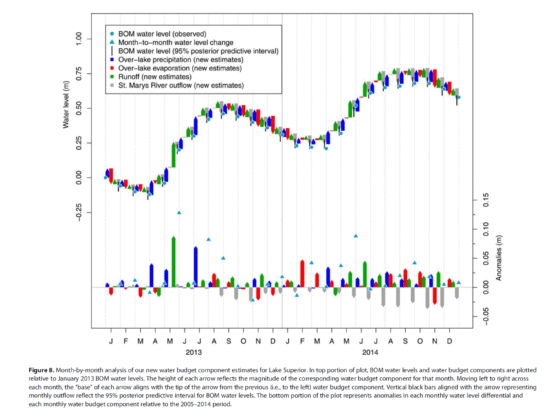As a followup to my cursory analysis suggesting increased precipitation was the probable cause of the record rise in Lake Superior water levels during 2013-2014, the GLERL folks pointed me to a relatively recent paper they published (Hydrologic Drivers of Record-Setting Water Level Rise on Earth’s Largest Lake System) which provides a detailed analysis of all of the hydrologic inputs and outputs to the levels of the separate Great Lakes (over-lake precipitation and evaporation, land precipitation runoff into the lake, river and channel inflows and outflows).
The following plot from their paper provides their statistically optimized estimates of the various hydrologic components that cause levels to change on Lake Superior. I suspect the most accurate measurements are the lake levels and outflow through the St. Marys River. Precipitation would be less well measured, and evaporation would be even more uncertain. Use the top portion to see the water level rise over the January 2013 thru December 2014 period, and use the bottom plot to understand the components that went into the rise, where arrows pointing up increase lake levels, and those pointing down decrease lake levels, compared to the long-term averages for those months (click on image for large version).
The bottom line is that the record rise in lake levels was mostly the result of above-normal precipitation (the blue [lake precip] and green [runoff from land precipitation] bars extending above the zero line). But also important was reduced evaporation (red bars) from the very cold winter of 2013-2014, which led to extensive ice cover and unusually cold lake water during the following summer.
Finally, note the grey bars, which indicate increased outflow through the St. Marys River at Sault Ste. Marie, MI, starting in mid-2013, which acted to limit the lake water rise.
As an aside, there is an interesting analogy between water storage in lakes, and heat storage in the ocean. There are inputs and outputs affecting each, and when there is a huge change (imbalance between inputs and outputs) it takes time for things to either depart from normal or go back to normal. Since the lake is small, that can happen in only a few years. In the case of heat storage in the ocean, it can take decades if not centuries for changes to be felt.

 Home/Blog
Home/Blog




